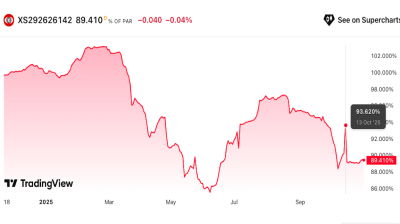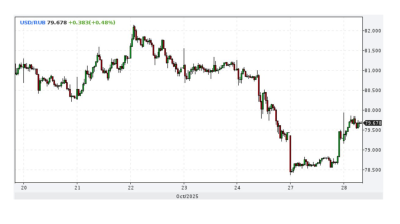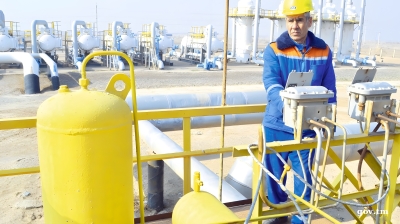The Turkish central bank’s monetary policy committee (MPC) on September 21 announced a policy rate hike of 500bp, taking the benchmark to 30% in line with market expectations (chart).
The gradual monetary tightening will continue, the MPC reiterated.
In June, following the appointment of Turkey’s post-election new economic team, the MPC launched the tightening cycle, taking the policy rate to 15% from 8.50% with a 650bp hike.
In July, it delivered 250bp. Both the June and July moves undershot market hopes and predictions.
In August, the MPC announced a policy rate hike of 750 bp, far larger than expected by the market. That took the benchmark to 25%. The market expectation was for 250bp.
The last two hikes have been significantly more to the global finance industry’s taste.
The next MPC meeting is scheduled for October 26. As things stand, it seems another 500bp is on the way.
Official inflation readings were above expectations in July and August, the MPC statement accompanying the rates announcement noted.
The strong course of domestic demand and the stickiness of services inflation persist, while increased oil prices and the ongoing deterioration in Turkish inflation expectations pose additional upside risks to inflation, according to the committee.
These factors imply year-end inflation close to the upper boundary of the forecast range provided in the central bank’s inflation report, the MPC observed.
In July, the central bank hiked its forecast for end-2023 official inflation to 58% from the 22% given in the May inflation report. Also, the upper boundary was moved up to 62% from 27%.
Moreover, the central bank said it anticipated that official inflation would peak at just below the 70%-level in May 2024.
On September 6, in the new medium-term economic programme (OVP), the Erdogan regime pencilled in an end-2023 inflation expectation of 65%.
(Sceptical observers of the administration’s economic manoeuvring will tell you that the OVP is, as usual, utter trash. They note that a new “PR wave” bigging up Turkey’s prospects swept the media with the release of the OVP. However, it wasn’t long before it started to fizzle, they say. However, another PR campaign is under way, observe these critics. This one, they note, suggests that foreign capital is raining down on Turkey.)
On November 2, the central bank will release its next inflation report and updated inflation forecasts.
The committee has also evaluated that tax regulations and cost pressures stemming from wages and exchange rates, which have been pushing up inflation, have broadly passed through to prices, and that the underlying trend in monthly inflation is on course for a decline.
Given the situation as regards the preparation of Turkey’s official data series (the deployed methodology is not to be trusted, warn critics) the sharply upward trend seen in the monthly inflation releases of July and August may smooth out in September and following months.
On September 5, the Turkish Statistical Institute (TUIK, or TurkStat) said that Turkey’s official consumer price index (CPI) inflation stood at 59% y/y in August versus 48% y/y in July and 38% in June.
The MPC is also talking about foreign direct investment, an improvement in external financing conditions, an ongoing increase in the FX reserves, the positive impact of tourism revenues on the current account balance and increasing domestic and foreign demand seen for Turkish lira-denominated assets.
It is also referring to the simplification of the micro- and macroprudential framework and a rising share of Turkish lira deposits, while also pointing to selective credit tightening.
The Erdogan economy team is intent on pushing a surreal PR campaign about capital flooding into Turkey, sigh the nonbelievers. Be sure to take onboard, they say, that there are no significant FDI flows seen in arrivals. The external debt rollovers are occurring at just below double-digit costs. The FX reserves are not recovering. The current account balance and trade balance are still “gone wild”. No one has any interest in Turkish papers.
In selective credit tightening, more complicated measures are being introduced. The share of Turkish lira deposits in overall deposits is not on the rise.
There’s some enjoyment to be had, add the “dissidents”, in wondering at the amazing positivity generated by the PR performance carried by the media—because it is produced by nothing more than the suggestion that the robust realism of the new "ex-Wall St" economic management will bring home the bacon.
And so one may conclude that the Erdogan regime keeps making a fool of everyone. The finance industry is not interested at all in what is coming out of the regime's mouth. It is simply awaiting the policy rate peak and the prize to be had from writing big returns in the rate-cutting period.
Prior to this main chance, the USD/TRY rate will be watched closely. It is still drawing a horizontal line at just below the 27-level, while Erdogan’s finance minister Mehmet Simsek repeatedly denies that he is intervening in the currency.
If a significant relaxation is observed in the pair, it will suggest that there are some capital inflows into the country.
Data

Russia’s manufacturing PMI falls to its lowest level since May 2022 in October
Russia’s manufacturing sector saw a deeper contraction in October, with output, new orders, and business confidence all weakening, according to the latest Purchasing Managers’ Index (PMI) data from S&P Global, published on November 1.

Czech growth accelerates as domestic demand-side pressure builds
The Czech economy delivered an unexpected acceleration in the third quarter, marking a clear shift from its earlier position as a regional underperformer to one of Central and Eastern Europe’s fastest-growing economies.

Eurobonds of Istanbul-listed Zorlu units offer attractive yields amid rating downgrades and no default expectation
Debut paper currently offering 14-15% yield.

Ruble strengthens as sanctioned oil companies repatriate cash
The Russian ruble strengthened after the Trump administration imposed oil sanctions on Russia’s leading oil companies, extending a rally that began after the Biden administration imposed oil sanctions on Russia in January.




